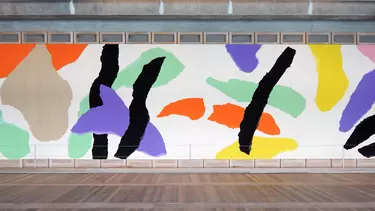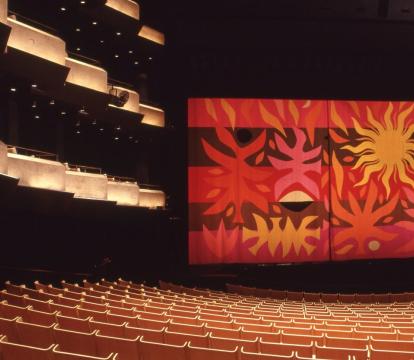Our storyConserving and celebrating our heritage
The Opera House is a World Heritage masterpiece of human creative genius. Jørn Utzon AC’s vision was not only to provide space for the performing arts, but to elevate and celebrate them. He designed a building to express this, which has become a performance in itself.
Described by UNESCO as “a great architectural work of the 20th century that brings together multiple strands of creativity and innovation in both architectural form and structural design,” the Opera House’s immense local and international cultural significance is reflected in its State, National and World Heritage listings.
The Opera House’s commitment to conservation ensures the building and performances it hosts can continue to be enjoyed by all, while enabling the evolution and change required of a living performing arts centre.
World Heritage
“Sydney Opera House stands by itself as one of the indisputable masterpieces of human creativity, not only in the 20th century but in the history of humankind” (International Council Report on Monuments and Sites to the World Heritage Committee).
On 28 June 2007 the Sydney Opera House was included on the UNESCO World Heritage List under the World Heritage Convention, placing it alongside the Taj Mahal, the ancient Pyramids of Egypt and the Great Wall of China as one of the most outstanding places on Earth.
According to UNESCO, the Sydney Opera House is a great architectural work of the 20th century that brings together multiple strands of creativity and innovation in both architectural form and structural design. “Its significance is based on its unparalleled design and construction,” UNESCO stated. “It is a daring and visionary experiment that has had an enduring influence on the emergent architecture of the late 20th century.
“Utzon's original design concept and his unique approach to building gave impetus to a collective creativity of architects, engineers and builders. Ove Arup's engineering achievements helped make Utzon's vision a reality” (UNESCO).
The design represents an extraordinary interpretation and response to the setting in Sydney Harbour. The Sydney Opera House is also of outstanding universal value for its achievements in structural engineering and building technology. The building is a great artistic monument and an icon, accessible to society at large.”
Read more about the Sydney Opera House’s inclusion on the UNESCO World Heritage List here.
Utzon’s Design Principles
In 1999, after extensive negotiations, Jørn Utzon agreed to develop a set of guidelines for future changes to the Sydney Opera House. It marked a moment of re-engagement between the architect and the building that had defined his career, but which he had never seen. The Utzon Design Principles enshrine Utzon’s original vision and help ensure the building’s architectural integrity is maintained as it evolves, as he said it should, to meet evolving needs.
Utzon’s attitude to modifications to the Opera House was set out in a letter dated 19 August 2000 he sent to Joe Skrzynski, then chair of the Sydney Opera House Trust. “As the architect of the Sydney Opera House, as the creative force behind its character, I sincerely believe that a large multipurpose structure such as this building, in time will undergo many natural changes,” Utzon wrote.
“The ideas as they were developed in the sixties, evolved as the result of the needs and technique at the time.
“As time passes and needs change, it is natural to modify the building to suit the needs and techniques of the day. The changes, however, should be such that the original character of the building is maintained.”
In September 2004, the Reception Hall was re-opened after being redesigned by Utzon and was renamed the Utzon Room in his honour.
The room, which has easterly views of Sydney Harbour, features a 14-metre long, floor-to-ceiling woollen tapestry that was also designed by Utzon. His first decorative artwork, the design was inspired by CPE Bach's Hamburg Symphonies and Raphael's painting, The Procession to Calvary. It was woven over eight months by the Victorian Tapestry Workshop, supervised by Utzon's daughter, the well-known artist Lin Utzon.

Of the naming of the room in his honour, Utzon said: “It gives me the greatest pleasure and satisfaction. I don't think you can give me more joy as the architect. It supersedes any medal of any kind that I could get and have got.”
The Utzon Room was followed by the first alteration to the exterior of the building: the addition of a Colonnade along the western side, which shades nine large glass openings into the previously solid exterior wall. This Utzon-led project, which was completed in 2006, gave the theatre foyers their first view of Sydney Harbour through windows modelled on Can Lis, the house he had built in Majorca. The foyers' interiors were also renovated to Utzon's specifications to become a coherent, attractive space for patrons.
On all projects, he worked with his architect son Jan and Sydney-based architect Richard Johnson of Johnson Pilton Walker.
In 2013, the Opera House celebrated the 40th anniversary of its opening. Embodying the enduring links between Australia and Denmark first forged by the Opera House, the Danish Crown Prince Couple, HRH Crown Prince Frederik and HRH Crown Princess Mary, were the official patrons of the 40th anniversary celebrations, which spanned 17 events attended by more than 30,000 people.
As part of the 40th anniversary, Deloitte delivered a report that estimated the value of the Opera House at $4.6 billion, underlining the scale of the windfall Australia has reaped from the vision and daring of previous generations.
The 40th anniversary also marked the beginning of the Opera House’s Decade of Renewal, a series of projects designed to ensure that Australia’s most famous building and busiest performing arts centre continued to inspire future generations of artists, audiences and visitors. The project touched all corners of the building, opening it to the public as never before. It was a finely tuned transformation that fused heritage and integrity with cutting-edge technology to ensure the Opera House lived up to the promise of the building itself.
The Decade of Renewal was the largest program of capital works since the Opera House opened in 1973. Generously funded by the NSW Government, the project involved replacing technology and machinery that had reached the end of their working life, opening new areas to the public and ensuring the Opera House was properly equipped to welcome as many people in as many ways as possible. The once-in-a-generation upgrade, totaling almost $300 million, culminated in the completion of the Concert Hall, which reopened in July 2022. As the Opera House prepares to celebrate its 50th anniversary in 2023, the stage has been set for a new era of creativity and connection.
The Creators Project Celebrating key creators of the Sydney Opera House
On 8 November 2023 the Sydney Opera House unveiled a series of plates honouring the contribution of Jørn Utzon, Ove Arup and Peter Hall in the creation of this iconic building, and the collective creativity of those involved from conception to construction.
Find out more about the Creators Project.
